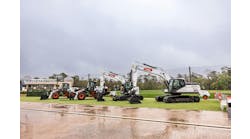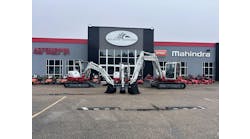Over the past decade, the rental industry has realized a simple fact — the majority of hole and trench digging on job sites is done at depths of 5 feet or less. While that may seem like an overwhelmingly obvious statement to some, it is a realization that has had a profound impact on equipment manufacturers.
Several manufacturers have introduced compact tractor loader backhoes (TLBs) in response to this market need. As a result, contractors are no longer required to rent or own large, cumbersome digging equipment that requires both a highly skilled operator and a large truck and trailer to transport. Instead, a compact, efficient, easy-to-use, easy-to-transport and relatively inexpensive TLB can perform virtually any necessary earthmoving tasks on today's job sites.
It's easy to see why rental centers' and rental customers' demand for compact TLBs continues to increase, and consequently, why the market is saturated with manufacturers offering this type of equipment. While such saturation can drive rental centers' acquisition costs down, it comes with a hidden price — product quality. Unfortunately, all compact TLBs are not the same. In order to ensure rental centers select a piece of equipment that will reap the most profits, they must first consider several important factors.
The Backhoe
The backhoe design is, perhaps, the single greatest factor rental centers should consider when acquiring a compact TLB. Rental centers should choose TLBs that offer a durable, powerful, industrial-class backhoe with replaceable composite bearings and oversized pins. A TLB with such a ruggedly designed backhoe will last longer in rental fleets, increasing return on investment.
Ideally, a backhoe design should incorporate both oversized polished pins with composite bearings that prevent any metal-to-metal contact, and urethane lip seals in all working joints that work to keep dirt out and grease in. These two components work together to greatly reduce friction and extend service intervals.
The size of a backhoe's swing arc is another factor to consider. Some models offer a full 180-degree swing — a feature that allows for precise work in tight areas such as along building foundations or other obstructions. Hydraulically cushioned swing cylinders prevent the backhoe from crashing into its swing stops and minimizing operator fatigue.
Hydraulics
Recent advancements in component technology have been a major contributor to TLB performance and will continue to be an area of notable development. Load-sensing hydraulic steering systems are a prime example of such improvements and can deliver significant benefits to rental centers' customers. This new technology ensures that hydraulic flow is used only when the operator is turning the wheel. Along with reducing steering effort, load-sensing hydraulic steering systems also increase productivity and enhance performance by providing the maximum available hydraulic power to the backhoe, loader or attachment.
Some manufacturers offer servo-controlled hydrostatic transmissions. The servo-control feature equalizes hydraulic pressure on the swash plate when operators release the travel pedal, eliminating creep. This feature also delivers finite control of the machine as well as reduced pedal effort in forward and reverse travel modes.
Hydraulic oil coolers are another important feature for rental centers to consider. Compact machines with high-performance hydraulic systems can easily build up heat, and without a large-capacity hydraulic oil cooler, machines will experience increased downtime and a shortened overall service life.
Overall design and safety
As with all rental equipment, a rugged, durable overall design is important for compact TLBs. Look for machines with oversize tie rods and high-capacity axles. Full-floating rear axle assemblies with four-pinion gears provide much-needed strength and stability and enable a unit to handle applications with severe terrain.
In this era, rental customers are expecting TLBs to be more and more versatile. The “tool carrier” concept — one machine that can perform multiple tasks — is becoming very popular. Rental customers want a versatile machine that can utilize a number of different attachments. Compact TLBs should feature auxiliary hydraulic PTOs that are easily accessible and have the capacity to power attachments such as multi-purpose buckets, grapple forks, compactors, breakers, cut off saws, jackhammers or crimpers.
For safety features, rental centers should look for machines with certified four-post roll over protective structures and seatbelts. Some models feature a heavy-duty boom lock that can be engaged or disengaged from the operator's seat. Boom locks increase safety when transporting and maneuvering a TLB to, from and around a job site.
For rental centers, compact TLBs present a proverbial gold mine. Not only has demand for them increased, but compact TLBs also offer low maintenance costs, are easy to transport, take up less space on a rental yard and their return on investment typically exceeds their “big brothers.” Additionally, these units are so easy-to-use that weekend warrior homeowners become viable customers. By carefully inspecting the backhoe, hydraulic system, size of the components and overall design of the TLBs, rental centers can be sure they choose a machine that will be digging up profits for years to come.
Rick Veenstra is a product manager for Allmand Bros., Holdrege, Neb.





